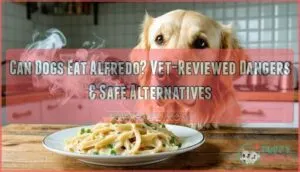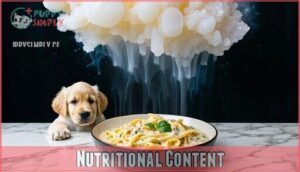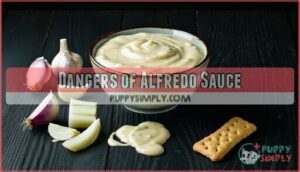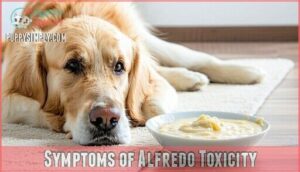This site is supported by our readers. We may earn a commission, at no cost to you, if you purchase through links.

The high fat content from butter and cream can trigger pancreatitis, a serious condition that causes severe abdominal pain. Most dogs can’t properly digest dairy either, leading to stomach upset and diarrhea.
Even small amounts can spell trouble for your furry friend. If your pup accidentally licks some alfredo off your plate, don’t panic, but watch for symptoms like vomiting or lethargy.
There are safer ways to share meal time with your dog.
Table Of Contents
- Key Takeaways
- What is Alfredo
- Can Dogs Eat Alfredo
- Dangers of Alfredo Sauce
- Symptoms of Alfredo Toxicity
- Helping Dogs After Alfredo Consumption
- Frequently Asked Questions (FAQs)
- Is it okay for dogs to eat alfredo sauce?
- Can dogs eat pasta with cream?
- Can dogs eat pasta with pasta sauce?
- Can dogs have vanilla cream?
- Is Alfredo safe for dogs to eat?
- Are there any health benefits to feeding Alfredo to dogs?
- Are there any alternatives to Alfredo that are safe for dogs?
- What are some of the risks associated with feeding Alfredo to dogs?
- How much Alfredo is too much for a dog to consume?
- How much alfredo sauce is toxic for dogs?
- Conclusion
Key Takeaways
- Don’t give your dog alfredo sauce – it contains toxic garlic and onions that damage red blood cells, plus high-fat dairy that can trigger painful pancreatitis
- Watch for serious symptoms if your dog accidentally eats alfredo – vomiting, lethargy, pale gums, excessive thirst, and abdominal pain all require immediate vet attention
- Even small amounts are dangerous – there’s no safe serving size since garlic and onions are toxic in any quantity, and the high sodium content can cause salt poisoning
- Choose dog-safe alternatives instead – offer plain cooked chicken, rice, or vet-approved treats that won’t upset your pup’s stomach or threaten their health
What is Alfredo
You’ve probably enjoyed creamy Alfredo sauce on pasta, but this rich Italian creation contains heavy cream, butter, parmesan cheese, and garlic that originated in Rome.
This traditional sauce packs 455 calories and 39 grams of fat per serving, making it a high-calorie indulgence that’s designed for human taste buds, with a particularly rich Italian creation.
History of Alfredo Sauce
Alfredo sauce traces its Italian origins back to 1914 Rome, where Chef Alfredo di Lelio created this rich Roman cuisine staple.
The sauce evolution began when he crafted it for his pregnant wife’s appetite. This historical context shows how a simple gesture became globally famous.
Understanding Alfredo sauce history helps explain why it’s problematic for canine consumption today, highlighting the importance of knowing the simple gesture that led to its creation.
Traditional Ingredients
Classic Alfredo sauce contains just a few simple ingredients that spell trouble for your furry friend.
Heavy cream and butter form the rich base, while Parmesan cheese adds that signature flavor.
Garlic content varies by recipe, though traditional versions use plenty, and Italian seasoning and sodium round out this dairy-heavy sauce that’s basically a perfect storm for dogs.
Nutritional Content
Looking at the nutritional content reveals why Alfredo sauce spells trouble for your dog’s diet.
One serving packs 455 calories with 39g fat and 949mg sodium – that’s a calorie bomb your pup doesn’t need.
While it contains protein and vitamins, the fat analysis shows dangerous levels that outweigh any benefits for canine nutrition and pet food safety.
Understanding the sauce nutrition facts is essential for making informed decisions about your dog’s diet.
Can Dogs Eat Alfredo
Unfortunately, dogs shouldn’t eat alfredo sauce due to serious health risks.
Unfortunately, alfredo sauce and dogs don’t mix—this creamy indulgence poses serious health risks for your furry friend.
This popular pasta topping contains multiple ingredients that can harm your furry friend, making it a definite no-go for responsible pet care and dog nutrition.
Here’s why alfredo poses serious food safety concerns:
- Toxic ingredients like garlic and onions can damage your dog’s red blood cells
- High-fat dairy products trigger painful pancreatitis and digestive upset
- Excessive sodium levels lead to dangerous salt poisoning and dehydration.
When it comes to toxic foods for dogs, alfredo sauce ranks high on the avoid list.
Similarly, garlic poses toxicity to dogs, making pesto another dangerous food.
Dangers of Alfredo Sauce
While Alfredo sauce might seem harmless, it contains several ingredients that pose serious health risks to your dog.
The combination of high-fat dairy, toxic garlic and onions, and excessive sodium can trigger digestive upset, pancreatitis, and even life-threatening toxicity in canines, which is a serious health concern.
High Fat Content
The creamy richness that makes Alfredo sauce irresistible creates serious health risks for dogs.
High fat content from butter, cream, and cheese overwhelms their digestive systems, triggering pancreatitis and weight gain.
Dogs metabolize fats differently than humans, making portion control critical when considering dogs and alfredo sauce.
As detailed by experts, excessive fat intake can lead to serious digestive upset.
| Fat Source | Health Risk |
|---|---|
| Heavy Cream | Digestive Issues |
| Butter | Pancreatitis Risk |
| Parmesan Cheese | Weight Gain |
| Combined Fats | Fat Metabolism Problems |
| High-Fat Dairy | Gastrointestinal Upset |
Onion and Garlic Toxicity
Garlic and onion from the Allium genus pose serious threats to your dog’s health.
Members of the Allium family are silent killers lurking in your kitchen pantry.
These toxic ingredients cause Allium Poisoning by damaging Red Blood Cells, leading to severe Anemia Risk.
Even small amounts reach the Toxic Dose threshold, potentially causing Breathing Problems.
Cooking doesn’t eliminate toxicity—15-30 grams per kilogram of body weight triggers dangerous hematologic changes in dogs.
Certain breeds are more susceptible to oxidative hemolysis from Allium spp. ingestion.
Dairy Ingredients
Beyond garlic concerns, alfredo sauce’s dairy foundation poses serious digestive risks for your dog.
Lactose intolerance affects most adult dogs, making cream and cheese problematic ingredients.
Butter’s high saturated fat content can trigger pancreatitis, while cheese may cause gas and stomach upset.
These creamy components offer minimal nutritional benefits but maximum digestive disruption for your furry friend.
Sodium Content
Alfredo sauce packs a dangerous sodium punch that can trigger salt poisoning in your dog.
Just one serving contains 949mg of sodium – way beyond what dogs need.
This excess salt causes hypernatremia risks, forcing kidneys to work overtime and potentially damaging heart health.
Sodium toxicity symptoms include excessive thirst, vomiting, and seizures, making alfredo sauce a serious dog health risk.
Symptoms of Alfredo Toxicity
If your dog eats Alfredo sauce, you’ll need to watch for several warning signs that indicate toxicity.
These symptoms can appear within hours and range from mild digestive upset to serious conditions requiring immediate veterinary care, which can be a sign of serious conditions.
Pancreatitis Symptoms
Pancreatitis strikes when your dog’s pancreas becomes inflamed from high-fat foods like Alfredo sauce.
Watch for repeated vomiting signs, loss of appetite, and obvious lethargy causes.
Your pup might show abdominal pain by hunching or whimpering, plus fever risks that make them feel miserable.
These dog symptoms indicate serious digestive issues requiring immediate veterinary attention.
Garlic and Onion Toxicity Symptoms
Recognizing garlic and onion dog poisoning requires watching for specific warning signs that develop within hours.
These toxic ingredients damage red blood cells, creating serious health emergencies that demand immediate veterinary attention. One should also be aware that onions cause oxidative damage to red blood cells.
- Pale Gums and yellow mucous membranes indicate severe anemia from red blood cell destruction
- Increased Heartrate and breathing difficulty as your dog’s body struggles with reduced oxygen delivery
- Abdominal Pain accompanied by weakness and lethargy from garlic or onion dog toxicity
Sodium Toxicity Symptoms
When your dog consumes too much sodium from Alfredo sauce, watch for concerning signs like excessive thirst response and muscle tremors.
Hypernatremia risks include seizures requiring immediate veterinary intervention.
Salt toxicity manifests as disorientation, vomiting, and loss of coordination.
Sodium ion poisoning can escalate quickly, making seizure management critical.
Don’t wait—hypernatremia demands professional treatment to prevent life-threatening complications.
Dairy Intolerance Symptoms
Lactose intolerance strikes many dogs after consuming dairy-rich Alfredo sauce.
You’ll notice bloating and gas within hours, followed by greasy stools and diarrhea onset.
Vomiting signs typically appear alongside gastrointestinal issues.
Some dogs develop skin reactions like hives or itching.
These dog food allergy symptoms indicate your pet’s digestion can’t handle dairy products properly.
Helping Dogs After Alfredo Consumption
If your dog has eaten alfredo sauce, you’ll need to act quickly to minimize potential health risks.
Monitor your pet closely for symptoms like vomiting, diarrhea, or lethargy, and contact your veterinarian immediately if you notice any concerning signs, which can help prevent serious complications.
Immediate Actions
When your dog sneaks a taste of Alfredo sauce, quick action prevents complications. Remove remaining sauce immediately and monitor for gastrointestinal signs like vomiting or lethargy.
Follow these immediate steps:
- Fasting Duration: Withhold food for 12-24 hours while providing fresh water
- Symptom Monitoring: Watch for dog pancreatitis signs and dog digestive issues
- Rice Introduction: Offer bland rice after fasting period
- Pepcid Dosage: Consider veterinarian-approved antacids for stomach upset
- Vet Consultation: Contact professionals if severe symptoms develop
For sensitive stomachs, consider easy to digest options.
Professional Advice
When symptoms persist beyond 24 hours, vet consultation becomes necessary.
Emergency treatment may prevent long-term effects on your dog’s pancreas and digestive system.
Expert opinions emphasize that dietary adjustments require professional guidance, especially for dogs eating human food regularly.
Veterinarians provide personalized dog nutrition advice considering canine food allergies and specific dog health risks your pet faces.
Dog Friendly Alternatives
Looking for better options? Try swapping out risky alfredo for dog-safe alternatives.
Bananas offer sweet treats, while carrots provide satisfying crunch. Plain chicken delivers protein without harmful additives. Scrambled eggs make excellent training rewards.
Natural peanut butter works great for puzzle toys. Many owners buy safe chewable options for their pets.
These safe dog foods give your pup delicious flavors without dangerous ingredients found in traditional recipes, making them a great choice for pet owners who want to provide healthy treats.
Prevention Methods
Your kitchen’s ingredient awareness serves as the first line of defense against accidental poisoning.
Keep human food dangers like Alfredo sauce away from curious paws through proper storage and portion control.
Regular dietary monitoring helps you spot problems early, while vet consultation confirms you’re following proper dog food safety protocols and offering safe alternatives instead.
Be aware that onion and garlic are toxic to dogs.
Frequently Asked Questions (FAQs)
Is it okay for dogs to eat alfredo sauce?
One serving of alfredo sauce packs 949mg of sodium—that’s dangerously high for dogs.
You shouldn’t give your pup alfredo sauce because it contains toxic garlic, onions, and dairy that’ll upset their stomach and potentially cause serious health issues.
Can dogs eat pasta with cream?
Pasta with cream isn’t ideal for your dog. The high-fat dairy can upset their stomach, cause diarrhea, or trigger pancreatitis. Plain cooked pasta’s safer, but skip the creamy sauces altogether.
Can dogs eat pasta with pasta sauce?
Most pasta sauces aren’t dog-friendly.
Tomato-based sauces contain garlic and onions, which are toxic to dogs.
Cream sauces pack too much fat, risking pancreatitis.
Plain cooked pasta’s safer than sauced versions for your pup.
Can dogs have vanilla cream?
Surprisingly, many pet owners wonder about dessert treats when their dogs give those pleading eyes.
You shouldn’t give your dog vanilla cream—it’s loaded with dairy, sugar, and artificial flavors that’ll upset their stomach and cause digestive issues.
Is Alfredo safe for dogs to eat?
No, Alfredo isn’t safe for dogs.
It contains garlic and onions which are toxic, plus high-fat dairy that can cause pancreatitis.
Even small amounts can trigger digestive upset or serious health complications.
Are there any health benefits to feeding Alfredo to dogs?
While you might think cheese provides calcium, feeding Alfredo to dogs offers zero health benefits.
The high-fat dairy, toxic garlic, and excessive sodium create serious health risks without any nutritional advantages for your furry friend, as there are no health benefits.
Are there any alternatives to Alfredo that are safe for dogs?
You’ll find safer options like plain cooked chicken, rice, or dog-friendly "pasta" made from sweet potato.
Skip dairy-heavy sauces and stick with simple, vet-approved treats that won’t upset your pup’s stomach.
What are some of the risks associated with feeding Alfredo to dogs?
Feeding your dog Alfredo can trigger pancreatitis from high-fat dairy ingredients.
Garlic and onions cause red blood cell damage, leading to anemia.
Excessive salt disrupts fluid balance, while lactose causes digestive upset.
How much Alfredo is too much for a dog to consume?
Any amount of Alfredo sauce is too much for your dog. Even a small lick can trigger digestive upset, while larger portions risk pancreatitis or garlic toxicity. Skip it entirely.
How much alfredo sauce is toxic for dogs?
Like a red flag waving danger, even a teaspoon of alfredo sauce can trigger digestive upset in dogs.
There’s no safe amount—garlic and onion are toxic in any quantity, making alfredo a no-go zone for your pup.
Conclusion
Clearly, the answer to "can dogs eat alfredo" is a definitive no. This creamy sauce poses multiple serious health risks including pancreatitis from high fat content and potential poisoning from garlic and onions.
Even small amounts can trigger dangerous symptoms requiring immediate veterinary attention. Instead of sharing your pasta, offer dog-safe alternatives like plain cooked chicken or specially formulated treats.
Your furry friend will appreciate the thoughtfulness without the health consequences that come with alfredo sauce. They will be safer and healthier with dog-safe alternatives.
- https://www.merckvetmanual.com/management-and-nutrition/nutrition-small-animals/nutritional-requirements-and-related-diseases-of-small-animals
- https://www.ncbi.nlm.nih.gov/pmc/articles/PMC4267359/
- https://www.vmccny.com/dr-maureen-luschini
- https://pangovet.com/?utm_source=dogster&utm_medium=article&utm_campaign=dog_eat_drink
- https://barksandrecct.com/2024/09/03/dangers-of-high-fat-foods-for-dogs












